QUT Nursing Case Study: Simon Hayes - Respiratory Distress Management
VerifiedAdded on 2023/02/01
|13
|3513
|23
Case Study
AI Summary
This case study focuses on Simon Hayes, a 14-year-old boy admitted to the emergency department with acute respiratory distress and wheezing, indicative of an asthma exacerbation. The assignment identifies two priority nursing problems: ineffective airway clearance and impaired gas exchange, linking them to the assessment data and underlying pathophysiology. Ineffective airway clearance is attributed to excessive mucus accumulation, airway edema, and bronchoconstriction, leading to wheezing. Impaired gas exchange is linked to reduced airway diameter and increased respiratory rate. The study proposes nursing interventions for each problem, supported by literature, including airway suctioning, nebulizer use, bronchodilators, oxygen administration, and medication administration. It highlights the importance of monitoring patient responses and arterial blood gases. The interventions aim to restore airway patency and improve gas exchange, ultimately promoting the patient's well-being. Evaluation of the interventions is also provided, including expected outcomes and patient responses.
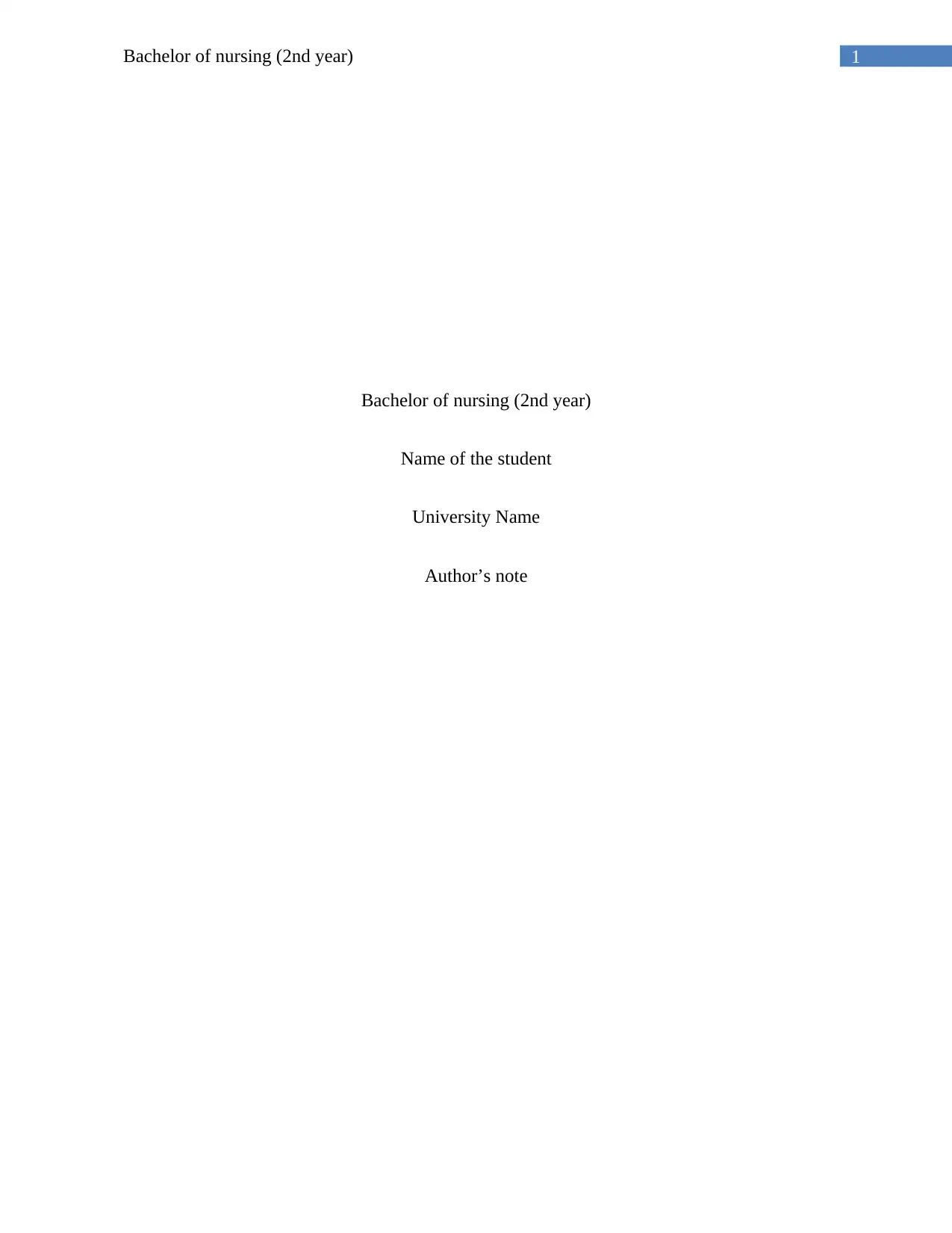
1Bachelor of nursing (2nd year)
Bachelor of nursing (2nd year)
Name of the student
University Name
Author’s note
Bachelor of nursing (2nd year)
Name of the student
University Name
Author’s note
Paraphrase This Document
Need a fresh take? Get an instant paraphrase of this document with our AI Paraphraser
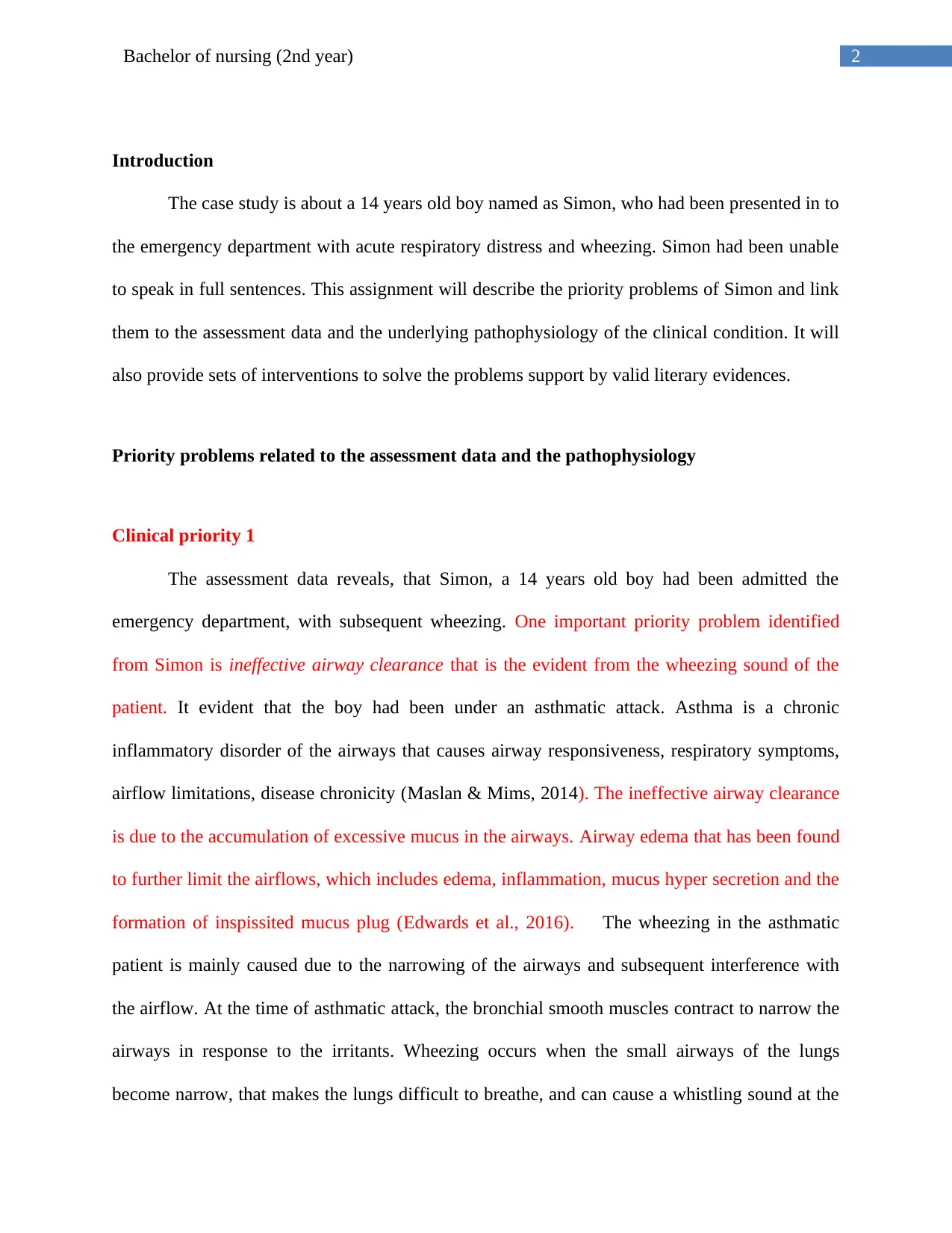
2Bachelor of nursing (2nd year)
Introduction
The case study is about a 14 years old boy named as Simon, who had been presented in to
the emergency department with acute respiratory distress and wheezing. Simon had been unable
to speak in full sentences. This assignment will describe the priority problems of Simon and link
them to the assessment data and the underlying pathophysiology of the clinical condition. It will
also provide sets of interventions to solve the problems support by valid literary evidences.
Priority problems related to the assessment data and the pathophysiology
Clinical priority 1
The assessment data reveals, that Simon, a 14 years old boy had been admitted the
emergency department, with subsequent wheezing. One important priority problem identified
from Simon is ineffective airway clearance that is the evident from the wheezing sound of the
patient. It evident that the boy had been under an asthmatic attack. Asthma is a chronic
inflammatory disorder of the airways that causes airway responsiveness, respiratory symptoms,
airflow limitations, disease chronicity (Maslan & Mims, 2014). The ineffective airway clearance
is due to the accumulation of excessive mucus in the airways. Airway edema that has been found
to further limit the airflows, which includes edema, inflammation, mucus hyper secretion and the
formation of inspissited mucus plug (Edwards et al., 2016). The wheezing in the asthmatic
patient is mainly caused due to the narrowing of the airways and subsequent interference with
the airflow. At the time of asthmatic attack, the bronchial smooth muscles contract to narrow the
airways in response to the irritants. Wheezing occurs when the small airways of the lungs
become narrow, that makes the lungs difficult to breathe, and can cause a whistling sound at the
Introduction
The case study is about a 14 years old boy named as Simon, who had been presented in to
the emergency department with acute respiratory distress and wheezing. Simon had been unable
to speak in full sentences. This assignment will describe the priority problems of Simon and link
them to the assessment data and the underlying pathophysiology of the clinical condition. It will
also provide sets of interventions to solve the problems support by valid literary evidences.
Priority problems related to the assessment data and the pathophysiology
Clinical priority 1
The assessment data reveals, that Simon, a 14 years old boy had been admitted the
emergency department, with subsequent wheezing. One important priority problem identified
from Simon is ineffective airway clearance that is the evident from the wheezing sound of the
patient. It evident that the boy had been under an asthmatic attack. Asthma is a chronic
inflammatory disorder of the airways that causes airway responsiveness, respiratory symptoms,
airflow limitations, disease chronicity (Maslan & Mims, 2014). The ineffective airway clearance
is due to the accumulation of excessive mucus in the airways. Airway edema that has been found
to further limit the airflows, which includes edema, inflammation, mucus hyper secretion and the
formation of inspissited mucus plug (Edwards et al., 2016). The wheezing in the asthmatic
patient is mainly caused due to the narrowing of the airways and subsequent interference with
the airflow. At the time of asthmatic attack, the bronchial smooth muscles contract to narrow the
airways in response to the irritants. Wheezing occurs when the small airways of the lungs
become narrow, that makes the lungs difficult to breathe, and can cause a whistling sound at the

3Bachelor of nursing (2nd year)
time of breathing out (Melen & Pershagen, 2012). The allergen –induced bronchoconstriction is
due to the release of IgE dependent release of the mediators from the mast cells, including the
histamines, tryptase, leukotrienes and the prostaglandins that directly comes in contact with the
smooth muscles (Doeing & Solway, 2013). Bronchoconstriction, where the smooth muscles of
the airways contract to narrow the airways in response to allergen. In case of Simon, it is evident
from the case study, that he was playing soccer, hence it can be said that he might have come in
exposure to certain allergens like cold air or pollen grains or normal dusts. Another phenomena
that occurs within the airways is the occurrence of airway edema (Seys et al., 2013). With the
progression of the disease, there are some other factors that limits the airflow through the
airways, such as excessive accumulation of mucus as well as structural changes including
hypertrophy and hyperplasia of the smooth muscles (Kudo, Ishigatsubo & Aoki, 2013). Airway
responsiveness is another factor that is an exaggerated bronchoconstrictor response to a wide
variety of stimuli. The mechanism behind the occurrence of airway hyperresponsive are multiple
and might include inflammation, dysfunctional neuro-regulation and the structural changes.
A nursing goal is normally constructed to help individuals, families, communities and
groups to reach an optimum state of wellbeing by restoring, maintain and promoting the health.
Hence a nursing goal will be developed for Simon.
Nursing Goals: To clear the secretions or obstructions from the respiratory tract for maintain a
clear airway.
Interventions
In case of excessive airway obstruction due to the accumulation of mucus plugs, it is first
necessary to assess the signs and the symptoms of airway obstruction (Amirzade et al.,
time of breathing out (Melen & Pershagen, 2012). The allergen –induced bronchoconstriction is
due to the release of IgE dependent release of the mediators from the mast cells, including the
histamines, tryptase, leukotrienes and the prostaglandins that directly comes in contact with the
smooth muscles (Doeing & Solway, 2013). Bronchoconstriction, where the smooth muscles of
the airways contract to narrow the airways in response to allergen. In case of Simon, it is evident
from the case study, that he was playing soccer, hence it can be said that he might have come in
exposure to certain allergens like cold air or pollen grains or normal dusts. Another phenomena
that occurs within the airways is the occurrence of airway edema (Seys et al., 2013). With the
progression of the disease, there are some other factors that limits the airflow through the
airways, such as excessive accumulation of mucus as well as structural changes including
hypertrophy and hyperplasia of the smooth muscles (Kudo, Ishigatsubo & Aoki, 2013). Airway
responsiveness is another factor that is an exaggerated bronchoconstrictor response to a wide
variety of stimuli. The mechanism behind the occurrence of airway hyperresponsive are multiple
and might include inflammation, dysfunctional neuro-regulation and the structural changes.
A nursing goal is normally constructed to help individuals, families, communities and
groups to reach an optimum state of wellbeing by restoring, maintain and promoting the health.
Hence a nursing goal will be developed for Simon.
Nursing Goals: To clear the secretions or obstructions from the respiratory tract for maintain a
clear airway.
Interventions
In case of excessive airway obstruction due to the accumulation of mucus plugs, it is first
necessary to assess the signs and the symptoms of airway obstruction (Amirzade et al.,
You're viewing a preview
Unlock full access by subscribing today!
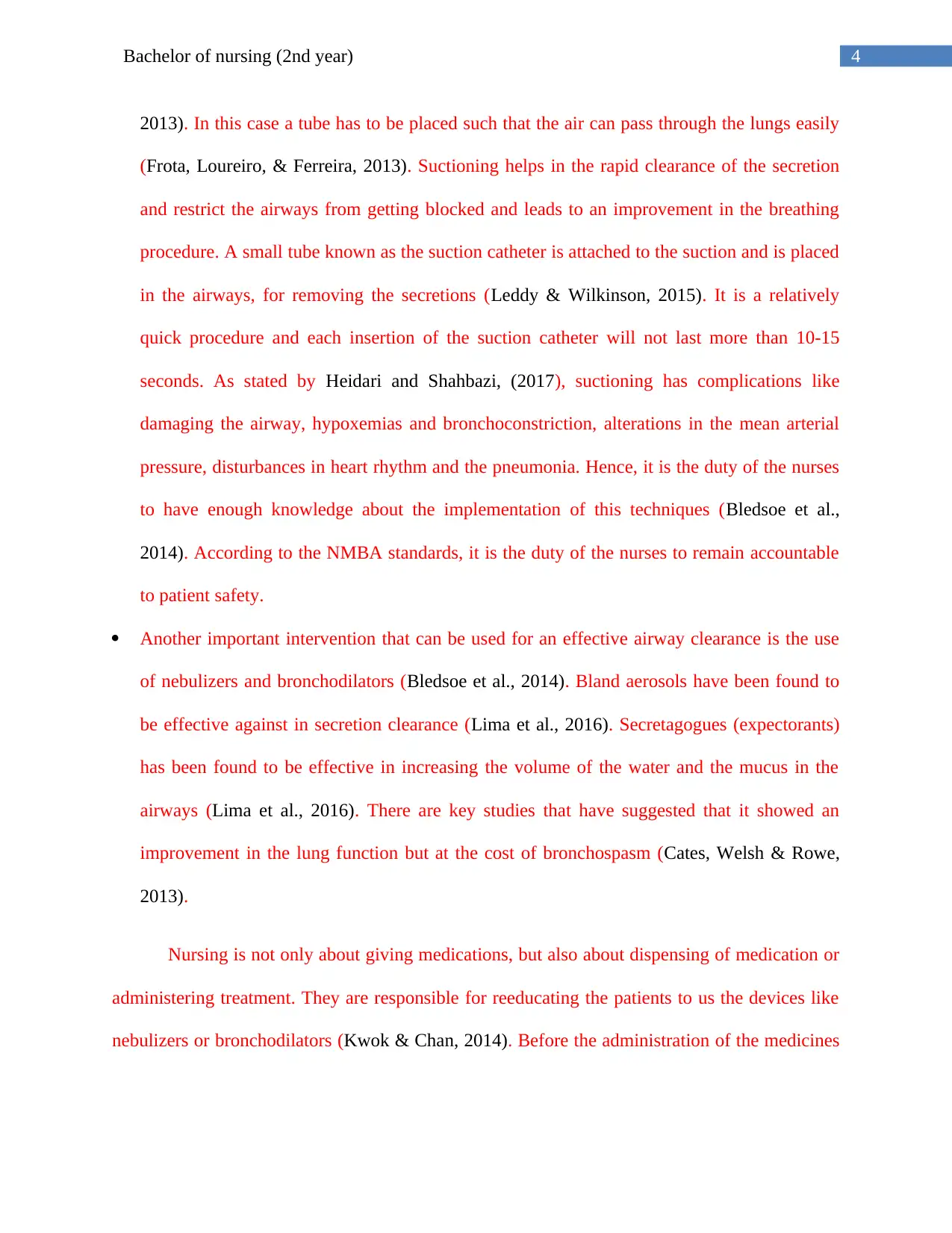
4Bachelor of nursing (2nd year)
2013). In this case a tube has to be placed such that the air can pass through the lungs easily
(Frota, Loureiro, & Ferreira, 2013). Suctioning helps in the rapid clearance of the secretion
and restrict the airways from getting blocked and leads to an improvement in the breathing
procedure. A small tube known as the suction catheter is attached to the suction and is placed
in the airways, for removing the secretions (Leddy & Wilkinson, 2015). It is a relatively
quick procedure and each insertion of the suction catheter will not last more than 10-15
seconds. As stated by Heidari and Shahbazi, (2017), suctioning has complications like
damaging the airway, hypoxemias and bronchoconstriction, alterations in the mean arterial
pressure, disturbances in heart rhythm and the pneumonia. Hence, it is the duty of the nurses
to have enough knowledge about the implementation of this techniques (Bledsoe et al.,
2014). According to the NMBA standards, it is the duty of the nurses to remain accountable
to patient safety.
Another important intervention that can be used for an effective airway clearance is the use
of nebulizers and bronchodilators (Bledsoe et al., 2014). Bland aerosols have been found to
be effective against in secretion clearance (Lima et al., 2016). Secretagogues (expectorants)
has been found to be effective in increasing the volume of the water and the mucus in the
airways (Lima et al., 2016). There are key studies that have suggested that it showed an
improvement in the lung function but at the cost of bronchospasm (Cates, Welsh & Rowe,
2013).
Nursing is not only about giving medications, but also about dispensing of medication or
administering treatment. They are responsible for reeducating the patients to us the devices like
nebulizers or bronchodilators (Kwok & Chan, 2014). Before the administration of the medicines
2013). In this case a tube has to be placed such that the air can pass through the lungs easily
(Frota, Loureiro, & Ferreira, 2013). Suctioning helps in the rapid clearance of the secretion
and restrict the airways from getting blocked and leads to an improvement in the breathing
procedure. A small tube known as the suction catheter is attached to the suction and is placed
in the airways, for removing the secretions (Leddy & Wilkinson, 2015). It is a relatively
quick procedure and each insertion of the suction catheter will not last more than 10-15
seconds. As stated by Heidari and Shahbazi, (2017), suctioning has complications like
damaging the airway, hypoxemias and bronchoconstriction, alterations in the mean arterial
pressure, disturbances in heart rhythm and the pneumonia. Hence, it is the duty of the nurses
to have enough knowledge about the implementation of this techniques (Bledsoe et al.,
2014). According to the NMBA standards, it is the duty of the nurses to remain accountable
to patient safety.
Another important intervention that can be used for an effective airway clearance is the use
of nebulizers and bronchodilators (Bledsoe et al., 2014). Bland aerosols have been found to
be effective against in secretion clearance (Lima et al., 2016). Secretagogues (expectorants)
has been found to be effective in increasing the volume of the water and the mucus in the
airways (Lima et al., 2016). There are key studies that have suggested that it showed an
improvement in the lung function but at the cost of bronchospasm (Cates, Welsh & Rowe,
2013).
Nursing is not only about giving medications, but also about dispensing of medication or
administering treatment. They are responsible for reeducating the patients to us the devices like
nebulizers or bronchodilators (Kwok & Chan, 2014). Before the administration of the medicines
Paraphrase This Document
Need a fresh take? Get an instant paraphrase of this document with our AI Paraphraser

5Bachelor of nursing (2nd year)
it is necessary for the nurses to check the dosage of the drugs and determine the baseline before
the administration of the medication.
Evaluation
With effective clearance of the airways, patients will be able to verbalize the cause and
the therapeutic management. The patient will display an airway patency by the clear breath
sounds improved by the oxygen rate, normal rate and the depth of respiration (Heidari &
Shahbazi, 2017).
Clinical priority 2: Impaired gaseous exchange
The second clinical priority is the impaired gas exchange. Impaired gas exchange is due
to the condition where the diameter of the airways is reduced. The airway resistance increases
that leads to a decrease in the amount of air entering by inspiration and expiration. Thus, the
ventilation is impaired. The balance between the ventilation and the perfusion is lost inspite of
adequate perfusion.
The assessment data has suggested that respiratory rate of the patient is about 32 breaths
per minute. Since, the amount of air introduced in the lungs is reduced with each breath per
minute, the person will have to breathe faster in shorter period of time in order to provide the
body with oxygen it needs for the functioning of the cells and the tissues. According to Kudo,
Ishigatsubo and Aoki, (2013), in lung conditions where the exchange of gas or the ventilation is
poor, the hypoxic and the hypercapnia drivers increases the respiratory rate to maintain the
SpO2. Reducing the amount of oxygen in the lung alveoli increases the rise in RR. Blood oxygen
level is the amount of oxygen circulating in the blood. The body closely monitors the oxygen
saturation level such that enough oxygen is there to be supplied to each of the cell of the body. A
it is necessary for the nurses to check the dosage of the drugs and determine the baseline before
the administration of the medication.
Evaluation
With effective clearance of the airways, patients will be able to verbalize the cause and
the therapeutic management. The patient will display an airway patency by the clear breath
sounds improved by the oxygen rate, normal rate and the depth of respiration (Heidari &
Shahbazi, 2017).
Clinical priority 2: Impaired gaseous exchange
The second clinical priority is the impaired gas exchange. Impaired gas exchange is due
to the condition where the diameter of the airways is reduced. The airway resistance increases
that leads to a decrease in the amount of air entering by inspiration and expiration. Thus, the
ventilation is impaired. The balance between the ventilation and the perfusion is lost inspite of
adequate perfusion.
The assessment data has suggested that respiratory rate of the patient is about 32 breaths
per minute. Since, the amount of air introduced in the lungs is reduced with each breath per
minute, the person will have to breathe faster in shorter period of time in order to provide the
body with oxygen it needs for the functioning of the cells and the tissues. According to Kudo,
Ishigatsubo and Aoki, (2013), in lung conditions where the exchange of gas or the ventilation is
poor, the hypoxic and the hypercapnia drivers increases the respiratory rate to maintain the
SpO2. Reducing the amount of oxygen in the lung alveoli increases the rise in RR. Blood oxygen
level is the amount of oxygen circulating in the blood. The body closely monitors the oxygen
saturation level such that enough oxygen is there to be supplied to each of the cell of the body. A
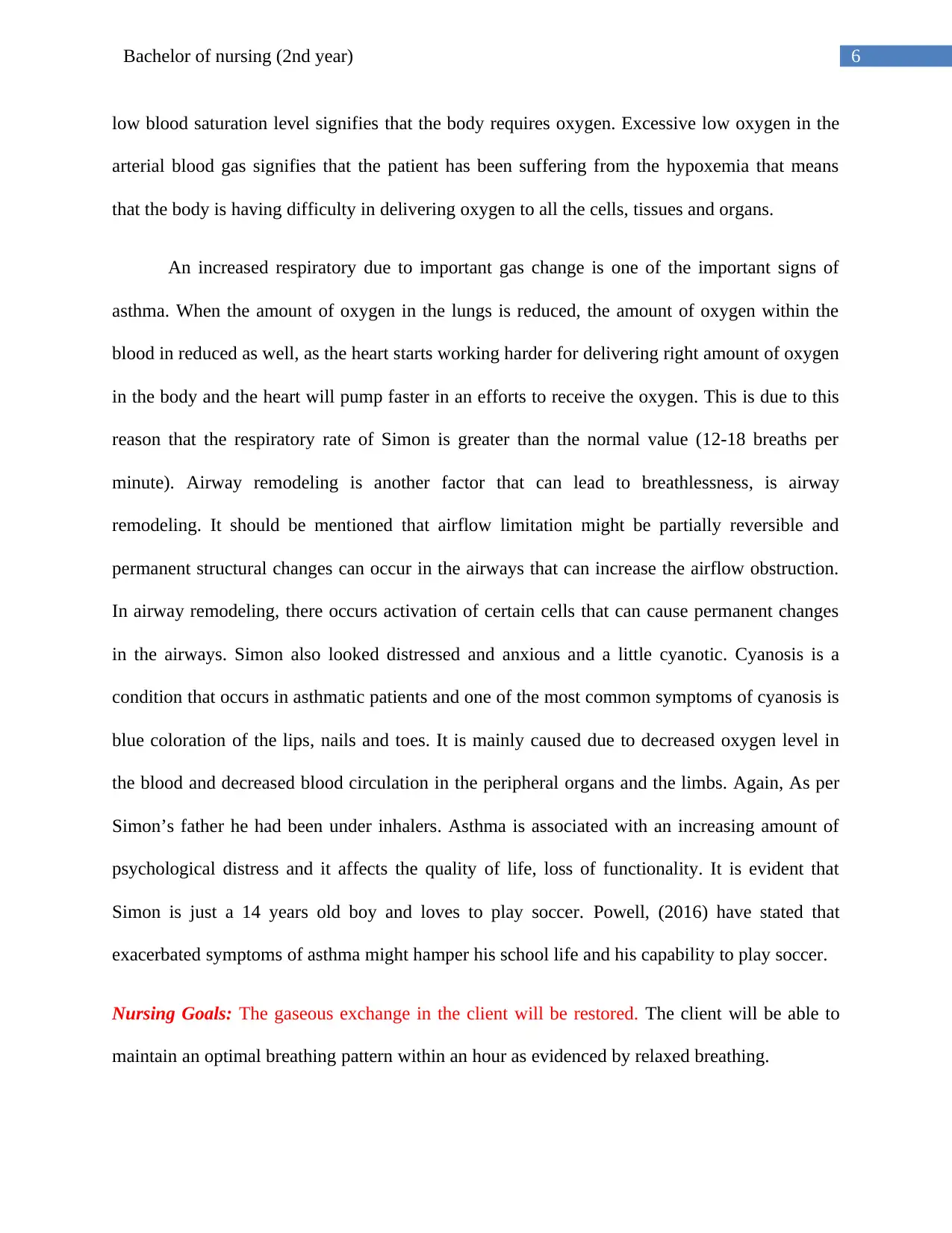
6Bachelor of nursing (2nd year)
low blood saturation level signifies that the body requires oxygen. Excessive low oxygen in the
arterial blood gas signifies that the patient has been suffering from the hypoxemia that means
that the body is having difficulty in delivering oxygen to all the cells, tissues and organs.
An increased respiratory due to important gas change is one of the important signs of
asthma. When the amount of oxygen in the lungs is reduced, the amount of oxygen within the
blood in reduced as well, as the heart starts working harder for delivering right amount of oxygen
in the body and the heart will pump faster in an efforts to receive the oxygen. This is due to this
reason that the respiratory rate of Simon is greater than the normal value (12-18 breaths per
minute). Airway remodeling is another factor that can lead to breathlessness, is airway
remodeling. It should be mentioned that airflow limitation might be partially reversible and
permanent structural changes can occur in the airways that can increase the airflow obstruction.
In airway remodeling, there occurs activation of certain cells that can cause permanent changes
in the airways. Simon also looked distressed and anxious and a little cyanotic. Cyanosis is a
condition that occurs in asthmatic patients and one of the most common symptoms of cyanosis is
blue coloration of the lips, nails and toes. It is mainly caused due to decreased oxygen level in
the blood and decreased blood circulation in the peripheral organs and the limbs. Again, As per
Simon’s father he had been under inhalers. Asthma is associated with an increasing amount of
psychological distress and it affects the quality of life, loss of functionality. It is evident that
Simon is just a 14 years old boy and loves to play soccer. Powell, (2016) have stated that
exacerbated symptoms of asthma might hamper his school life and his capability to play soccer.
Nursing Goals: The gaseous exchange in the client will be restored. The client will be able to
maintain an optimal breathing pattern within an hour as evidenced by relaxed breathing.
low blood saturation level signifies that the body requires oxygen. Excessive low oxygen in the
arterial blood gas signifies that the patient has been suffering from the hypoxemia that means
that the body is having difficulty in delivering oxygen to all the cells, tissues and organs.
An increased respiratory due to important gas change is one of the important signs of
asthma. When the amount of oxygen in the lungs is reduced, the amount of oxygen within the
blood in reduced as well, as the heart starts working harder for delivering right amount of oxygen
in the body and the heart will pump faster in an efforts to receive the oxygen. This is due to this
reason that the respiratory rate of Simon is greater than the normal value (12-18 breaths per
minute). Airway remodeling is another factor that can lead to breathlessness, is airway
remodeling. It should be mentioned that airflow limitation might be partially reversible and
permanent structural changes can occur in the airways that can increase the airflow obstruction.
In airway remodeling, there occurs activation of certain cells that can cause permanent changes
in the airways. Simon also looked distressed and anxious and a little cyanotic. Cyanosis is a
condition that occurs in asthmatic patients and one of the most common symptoms of cyanosis is
blue coloration of the lips, nails and toes. It is mainly caused due to decreased oxygen level in
the blood and decreased blood circulation in the peripheral organs and the limbs. Again, As per
Simon’s father he had been under inhalers. Asthma is associated with an increasing amount of
psychological distress and it affects the quality of life, loss of functionality. It is evident that
Simon is just a 14 years old boy and loves to play soccer. Powell, (2016) have stated that
exacerbated symptoms of asthma might hamper his school life and his capability to play soccer.
Nursing Goals: The gaseous exchange in the client will be restored. The client will be able to
maintain an optimal breathing pattern within an hour as evidenced by relaxed breathing.
You're viewing a preview
Unlock full access by subscribing today!
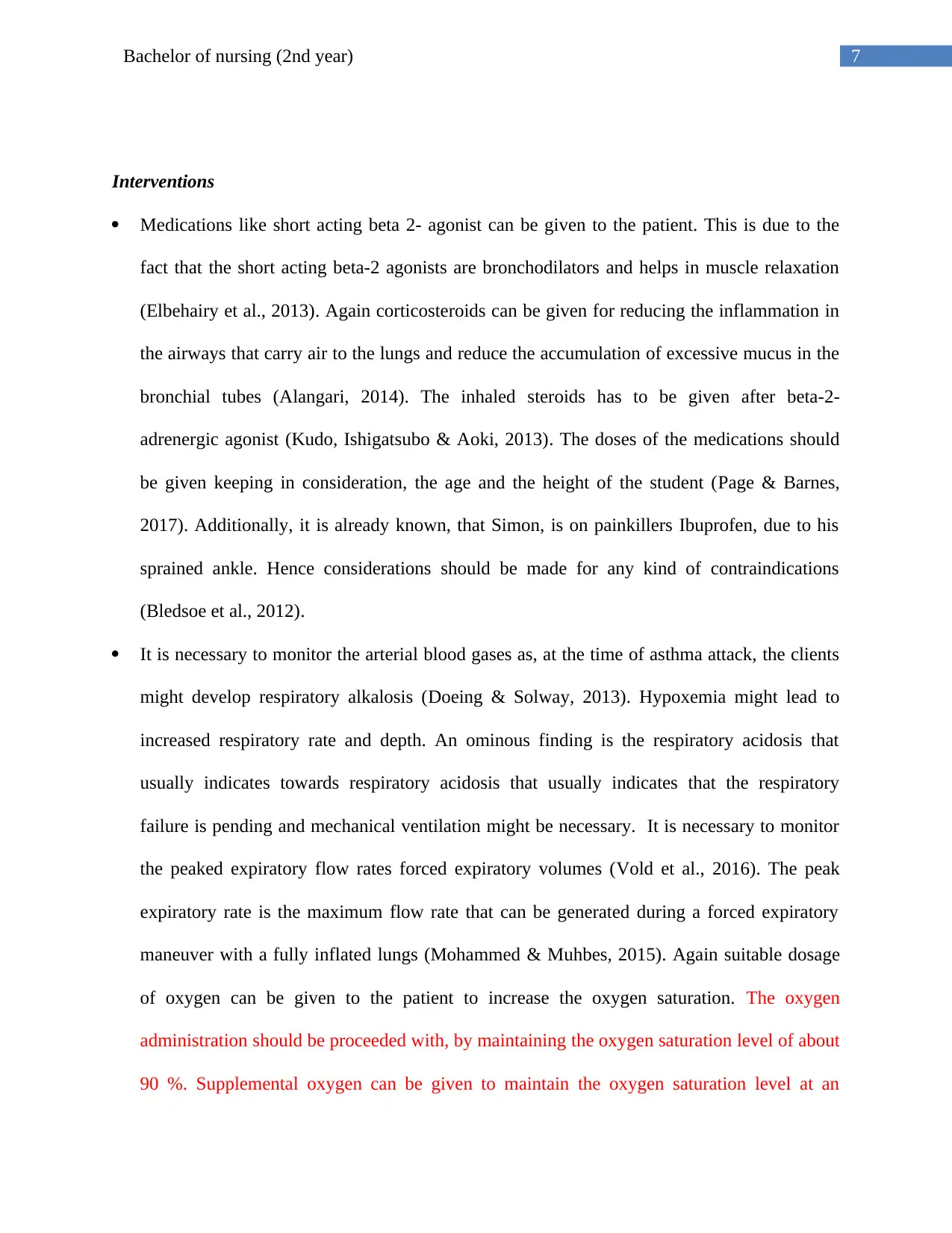
7Bachelor of nursing (2nd year)
Interventions
Medications like short acting beta 2- agonist can be given to the patient. This is due to the
fact that the short acting beta-2 agonists are bronchodilators and helps in muscle relaxation
(Elbehairy et al., 2013). Again corticosteroids can be given for reducing the inflammation in
the airways that carry air to the lungs and reduce the accumulation of excessive mucus in the
bronchial tubes (Alangari, 2014). The inhaled steroids has to be given after beta-2-
adrenergic agonist (Kudo, Ishigatsubo & Aoki, 2013). The doses of the medications should
be given keeping in consideration, the age and the height of the student (Page & Barnes,
2017). Additionally, it is already known, that Simon, is on painkillers Ibuprofen, due to his
sprained ankle. Hence considerations should be made for any kind of contraindications
(Bledsoe et al., 2012).
It is necessary to monitor the arterial blood gases as, at the time of asthma attack, the clients
might develop respiratory alkalosis (Doeing & Solway, 2013). Hypoxemia might lead to
increased respiratory rate and depth. An ominous finding is the respiratory acidosis that
usually indicates towards respiratory acidosis that usually indicates that the respiratory
failure is pending and mechanical ventilation might be necessary. It is necessary to monitor
the peaked expiratory flow rates forced expiratory volumes (Vold et al., 2016). The peak
expiratory rate is the maximum flow rate that can be generated during a forced expiratory
maneuver with a fully inflated lungs (Mohammed & Muhbes, 2015). Again suitable dosage
of oxygen can be given to the patient to increase the oxygen saturation. The oxygen
administration should be proceeded with, by maintaining the oxygen saturation level of about
90 %. Supplemental oxygen can be given to maintain the oxygen saturation level at an
Interventions
Medications like short acting beta 2- agonist can be given to the patient. This is due to the
fact that the short acting beta-2 agonists are bronchodilators and helps in muscle relaxation
(Elbehairy et al., 2013). Again corticosteroids can be given for reducing the inflammation in
the airways that carry air to the lungs and reduce the accumulation of excessive mucus in the
bronchial tubes (Alangari, 2014). The inhaled steroids has to be given after beta-2-
adrenergic agonist (Kudo, Ishigatsubo & Aoki, 2013). The doses of the medications should
be given keeping in consideration, the age and the height of the student (Page & Barnes,
2017). Additionally, it is already known, that Simon, is on painkillers Ibuprofen, due to his
sprained ankle. Hence considerations should be made for any kind of contraindications
(Bledsoe et al., 2012).
It is necessary to monitor the arterial blood gases as, at the time of asthma attack, the clients
might develop respiratory alkalosis (Doeing & Solway, 2013). Hypoxemia might lead to
increased respiratory rate and depth. An ominous finding is the respiratory acidosis that
usually indicates towards respiratory acidosis that usually indicates that the respiratory
failure is pending and mechanical ventilation might be necessary. It is necessary to monitor
the peaked expiratory flow rates forced expiratory volumes (Vold et al., 2016). The peak
expiratory rate is the maximum flow rate that can be generated during a forced expiratory
maneuver with a fully inflated lungs (Mohammed & Muhbes, 2015). Again suitable dosage
of oxygen can be given to the patient to increase the oxygen saturation. The oxygen
administration should be proceeded with, by maintaining the oxygen saturation level of about
90 %. Supplemental oxygen can be given to maintain the oxygen saturation level at an
Paraphrase This Document
Need a fresh take? Get an instant paraphrase of this document with our AI Paraphraser
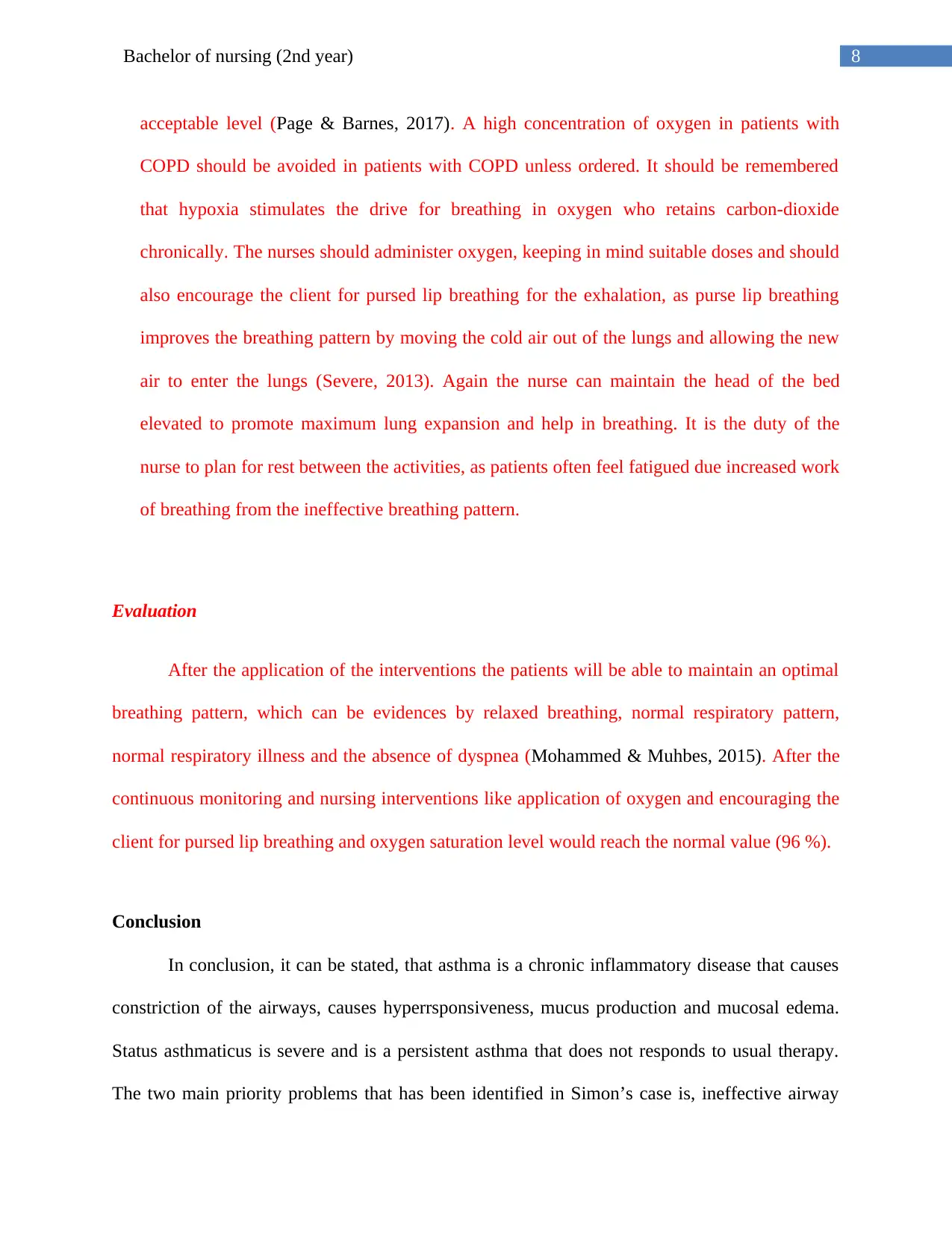
8Bachelor of nursing (2nd year)
acceptable level (Page & Barnes, 2017). A high concentration of oxygen in patients with
COPD should be avoided in patients with COPD unless ordered. It should be remembered
that hypoxia stimulates the drive for breathing in oxygen who retains carbon-dioxide
chronically. The nurses should administer oxygen, keeping in mind suitable doses and should
also encourage the client for pursed lip breathing for the exhalation, as purse lip breathing
improves the breathing pattern by moving the cold air out of the lungs and allowing the new
air to enter the lungs (Severe, 2013). Again the nurse can maintain the head of the bed
elevated to promote maximum lung expansion and help in breathing. It is the duty of the
nurse to plan for rest between the activities, as patients often feel fatigued due increased work
of breathing from the ineffective breathing pattern.
Evaluation
After the application of the interventions the patients will be able to maintain an optimal
breathing pattern, which can be evidences by relaxed breathing, normal respiratory pattern,
normal respiratory illness and the absence of dyspnea (Mohammed & Muhbes, 2015). After the
continuous monitoring and nursing interventions like application of oxygen and encouraging the
client for pursed lip breathing and oxygen saturation level would reach the normal value (96 %).
Conclusion
In conclusion, it can be stated, that asthma is a chronic inflammatory disease that causes
constriction of the airways, causes hyperrsponsiveness, mucus production and mucosal edema.
Status asthmaticus is severe and is a persistent asthma that does not responds to usual therapy.
The two main priority problems that has been identified in Simon’s case is, ineffective airway
acceptable level (Page & Barnes, 2017). A high concentration of oxygen in patients with
COPD should be avoided in patients with COPD unless ordered. It should be remembered
that hypoxia stimulates the drive for breathing in oxygen who retains carbon-dioxide
chronically. The nurses should administer oxygen, keeping in mind suitable doses and should
also encourage the client for pursed lip breathing for the exhalation, as purse lip breathing
improves the breathing pattern by moving the cold air out of the lungs and allowing the new
air to enter the lungs (Severe, 2013). Again the nurse can maintain the head of the bed
elevated to promote maximum lung expansion and help in breathing. It is the duty of the
nurse to plan for rest between the activities, as patients often feel fatigued due increased work
of breathing from the ineffective breathing pattern.
Evaluation
After the application of the interventions the patients will be able to maintain an optimal
breathing pattern, which can be evidences by relaxed breathing, normal respiratory pattern,
normal respiratory illness and the absence of dyspnea (Mohammed & Muhbes, 2015). After the
continuous monitoring and nursing interventions like application of oxygen and encouraging the
client for pursed lip breathing and oxygen saturation level would reach the normal value (96 %).
Conclusion
In conclusion, it can be stated, that asthma is a chronic inflammatory disease that causes
constriction of the airways, causes hyperrsponsiveness, mucus production and mucosal edema.
Status asthmaticus is severe and is a persistent asthma that does not responds to usual therapy.
The two main priority problems that has been identified in Simon’s case is, ineffective airway
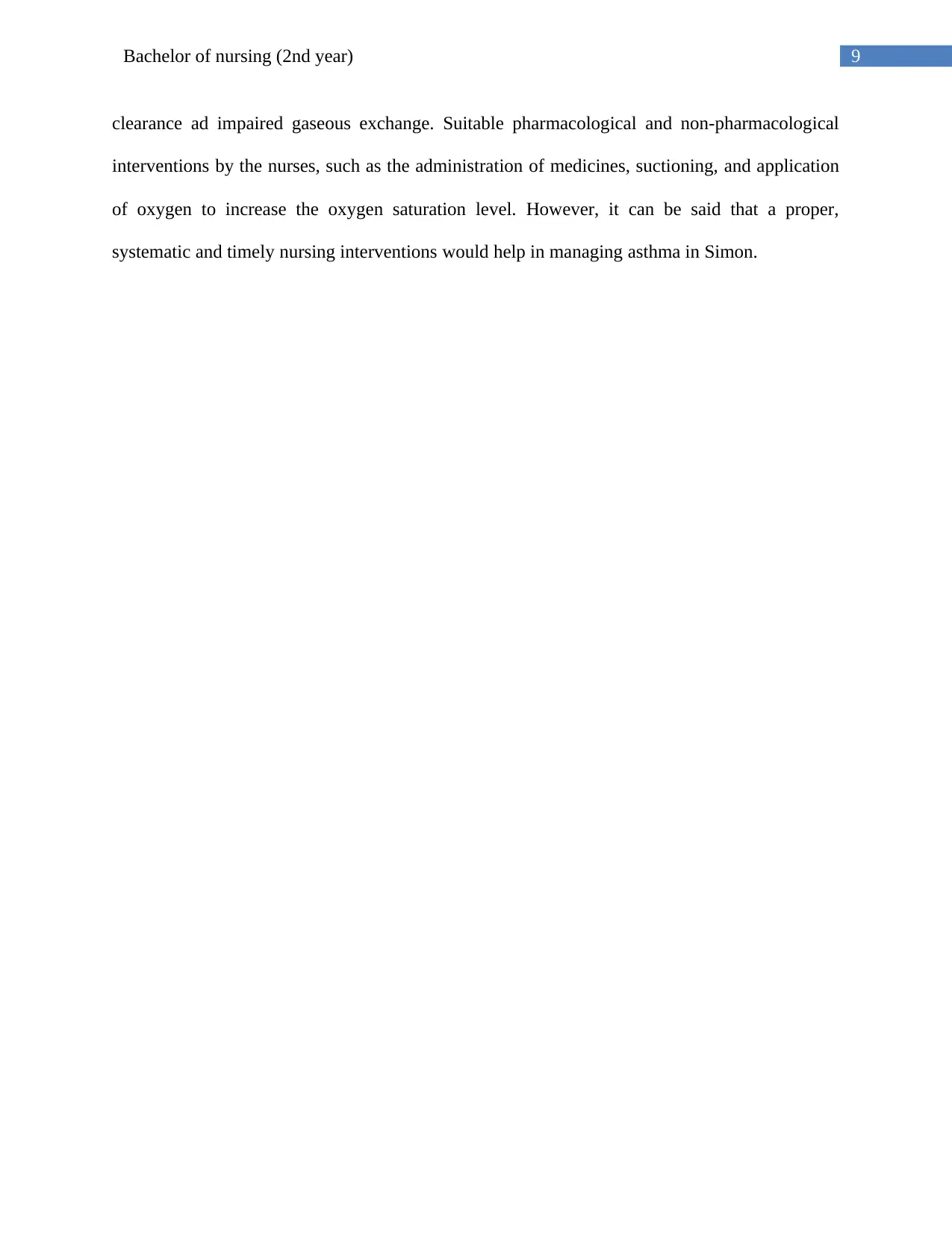
9Bachelor of nursing (2nd year)
clearance ad impaired gaseous exchange. Suitable pharmacological and non-pharmacological
interventions by the nurses, such as the administration of medicines, suctioning, and application
of oxygen to increase the oxygen saturation level. However, it can be said that a proper,
systematic and timely nursing interventions would help in managing asthma in Simon.
clearance ad impaired gaseous exchange. Suitable pharmacological and non-pharmacological
interventions by the nurses, such as the administration of medicines, suctioning, and application
of oxygen to increase the oxygen saturation level. However, it can be said that a proper,
systematic and timely nursing interventions would help in managing asthma in Simon.
You're viewing a preview
Unlock full access by subscribing today!
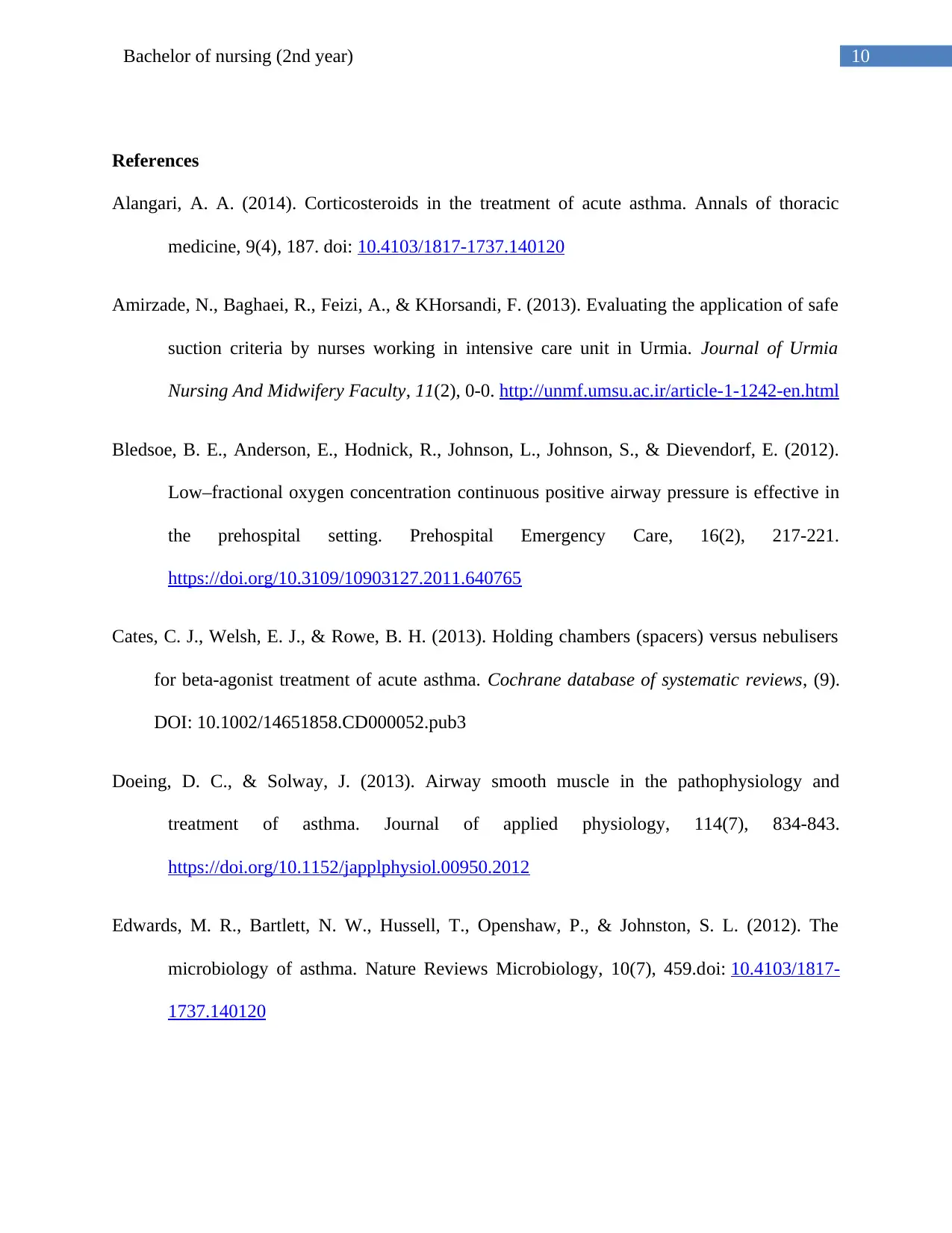
10Bachelor of nursing (2nd year)
References
Alangari, A. A. (2014). Corticosteroids in the treatment of acute asthma. Annals of thoracic
medicine, 9(4), 187. doi: 10.4103/1817-1737.140120
Amirzade, N., Baghaei, R., Feizi, A., & KHorsandi, F. (2013). Evaluating the application of safe
suction criteria by nurses working in intensive care unit in Urmia. Journal of Urmia
Nursing And Midwifery Faculty, 11(2), 0-0. http://unmf.umsu.ac.ir/article-1-1242-en.html
Bledsoe, B. E., Anderson, E., Hodnick, R., Johnson, L., Johnson, S., & Dievendorf, E. (2012).
Low–fractional oxygen concentration continuous positive airway pressure is effective in
the prehospital setting. Prehospital Emergency Care, 16(2), 217-221.
https://doi.org/10.3109/10903127.2011.640765
Cates, C. J., Welsh, E. J., & Rowe, B. H. (2013). Holding chambers (spacers) versus nebulisers
for beta‐agonist treatment of acute asthma. Cochrane database of systematic reviews, (9).
DOI: 10.1002/14651858.CD000052.pub3
Doeing, D. C., & Solway, J. (2013). Airway smooth muscle in the pathophysiology and
treatment of asthma. Journal of applied physiology, 114(7), 834-843.
https://doi.org/10.1152/japplphysiol.00950.2012
Edwards, M. R., Bartlett, N. W., Hussell, T., Openshaw, P., & Johnston, S. L. (2012). The
microbiology of asthma. Nature Reviews Microbiology, 10(7), 459.doi: 10.4103/1817-
1737.140120
References
Alangari, A. A. (2014). Corticosteroids in the treatment of acute asthma. Annals of thoracic
medicine, 9(4), 187. doi: 10.4103/1817-1737.140120
Amirzade, N., Baghaei, R., Feizi, A., & KHorsandi, F. (2013). Evaluating the application of safe
suction criteria by nurses working in intensive care unit in Urmia. Journal of Urmia
Nursing And Midwifery Faculty, 11(2), 0-0. http://unmf.umsu.ac.ir/article-1-1242-en.html
Bledsoe, B. E., Anderson, E., Hodnick, R., Johnson, L., Johnson, S., & Dievendorf, E. (2012).
Low–fractional oxygen concentration continuous positive airway pressure is effective in
the prehospital setting. Prehospital Emergency Care, 16(2), 217-221.
https://doi.org/10.3109/10903127.2011.640765
Cates, C. J., Welsh, E. J., & Rowe, B. H. (2013). Holding chambers (spacers) versus nebulisers
for beta‐agonist treatment of acute asthma. Cochrane database of systematic reviews, (9).
DOI: 10.1002/14651858.CD000052.pub3
Doeing, D. C., & Solway, J. (2013). Airway smooth muscle in the pathophysiology and
treatment of asthma. Journal of applied physiology, 114(7), 834-843.
https://doi.org/10.1152/japplphysiol.00950.2012
Edwards, M. R., Bartlett, N. W., Hussell, T., Openshaw, P., & Johnston, S. L. (2012). The
microbiology of asthma. Nature Reviews Microbiology, 10(7), 459.doi: 10.4103/1817-
1737.140120
Paraphrase This Document
Need a fresh take? Get an instant paraphrase of this document with our AI Paraphraser
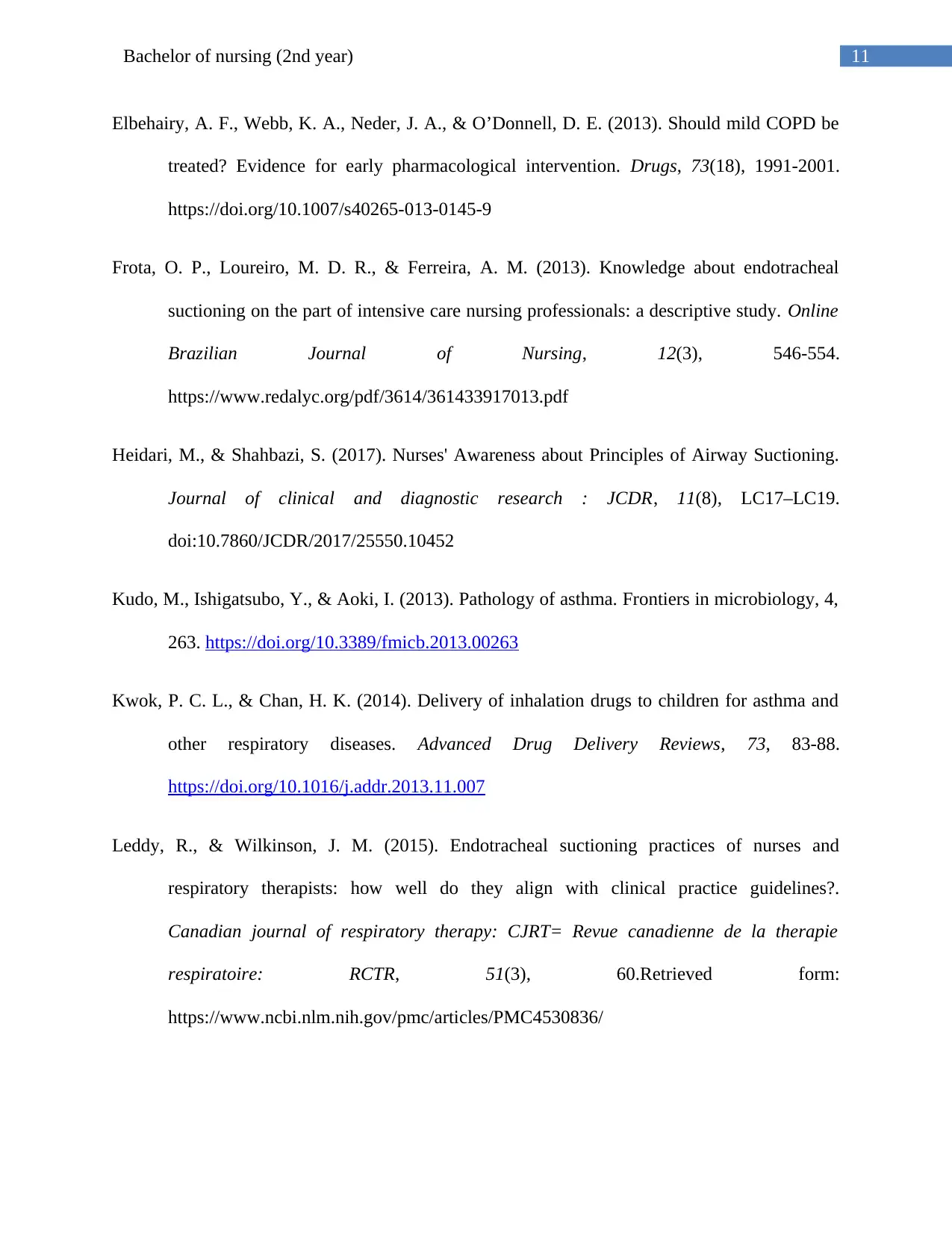
11Bachelor of nursing (2nd year)
Elbehairy, A. F., Webb, K. A., Neder, J. A., & O’Donnell, D. E. (2013). Should mild COPD be
treated? Evidence for early pharmacological intervention. Drugs, 73(18), 1991-2001.
https://doi.org/10.1007/s40265-013-0145-9
Frota, O. P., Loureiro, M. D. R., & Ferreira, A. M. (2013). Knowledge about endotracheal
suctioning on the part of intensive care nursing professionals: a descriptive study. Online
Brazilian Journal of Nursing, 12(3), 546-554.
https://www.redalyc.org/pdf/3614/361433917013.pdf
Heidari, M., & Shahbazi, S. (2017). Nurses' Awareness about Principles of Airway Suctioning.
Journal of clinical and diagnostic research : JCDR, 11(8), LC17–LC19.
doi:10.7860/JCDR/2017/25550.10452
Kudo, M., Ishigatsubo, Y., & Aoki, I. (2013). Pathology of asthma. Frontiers in microbiology, 4,
263. https://doi.org/10.3389/fmicb.2013.00263
Kwok, P. C. L., & Chan, H. K. (2014). Delivery of inhalation drugs to children for asthma and
other respiratory diseases. Advanced Drug Delivery Reviews, 73, 83-88.
https://doi.org/10.1016/j.addr.2013.11.007
Leddy, R., & Wilkinson, J. M. (2015). Endotracheal suctioning practices of nurses and
respiratory therapists: how well do they align with clinical practice guidelines?.
Canadian journal of respiratory therapy: CJRT= Revue canadienne de la therapie
respiratoire: RCTR, 51(3), 60.Retrieved form:
https://www.ncbi.nlm.nih.gov/pmc/articles/PMC4530836/
Elbehairy, A. F., Webb, K. A., Neder, J. A., & O’Donnell, D. E. (2013). Should mild COPD be
treated? Evidence for early pharmacological intervention. Drugs, 73(18), 1991-2001.
https://doi.org/10.1007/s40265-013-0145-9
Frota, O. P., Loureiro, M. D. R., & Ferreira, A. M. (2013). Knowledge about endotracheal
suctioning on the part of intensive care nursing professionals: a descriptive study. Online
Brazilian Journal of Nursing, 12(3), 546-554.
https://www.redalyc.org/pdf/3614/361433917013.pdf
Heidari, M., & Shahbazi, S. (2017). Nurses' Awareness about Principles of Airway Suctioning.
Journal of clinical and diagnostic research : JCDR, 11(8), LC17–LC19.
doi:10.7860/JCDR/2017/25550.10452
Kudo, M., Ishigatsubo, Y., & Aoki, I. (2013). Pathology of asthma. Frontiers in microbiology, 4,
263. https://doi.org/10.3389/fmicb.2013.00263
Kwok, P. C. L., & Chan, H. K. (2014). Delivery of inhalation drugs to children for asthma and
other respiratory diseases. Advanced Drug Delivery Reviews, 73, 83-88.
https://doi.org/10.1016/j.addr.2013.11.007
Leddy, R., & Wilkinson, J. M. (2015). Endotracheal suctioning practices of nurses and
respiratory therapists: how well do they align with clinical practice guidelines?.
Canadian journal of respiratory therapy: CJRT= Revue canadienne de la therapie
respiratoire: RCTR, 51(3), 60.Retrieved form:
https://www.ncbi.nlm.nih.gov/pmc/articles/PMC4530836/
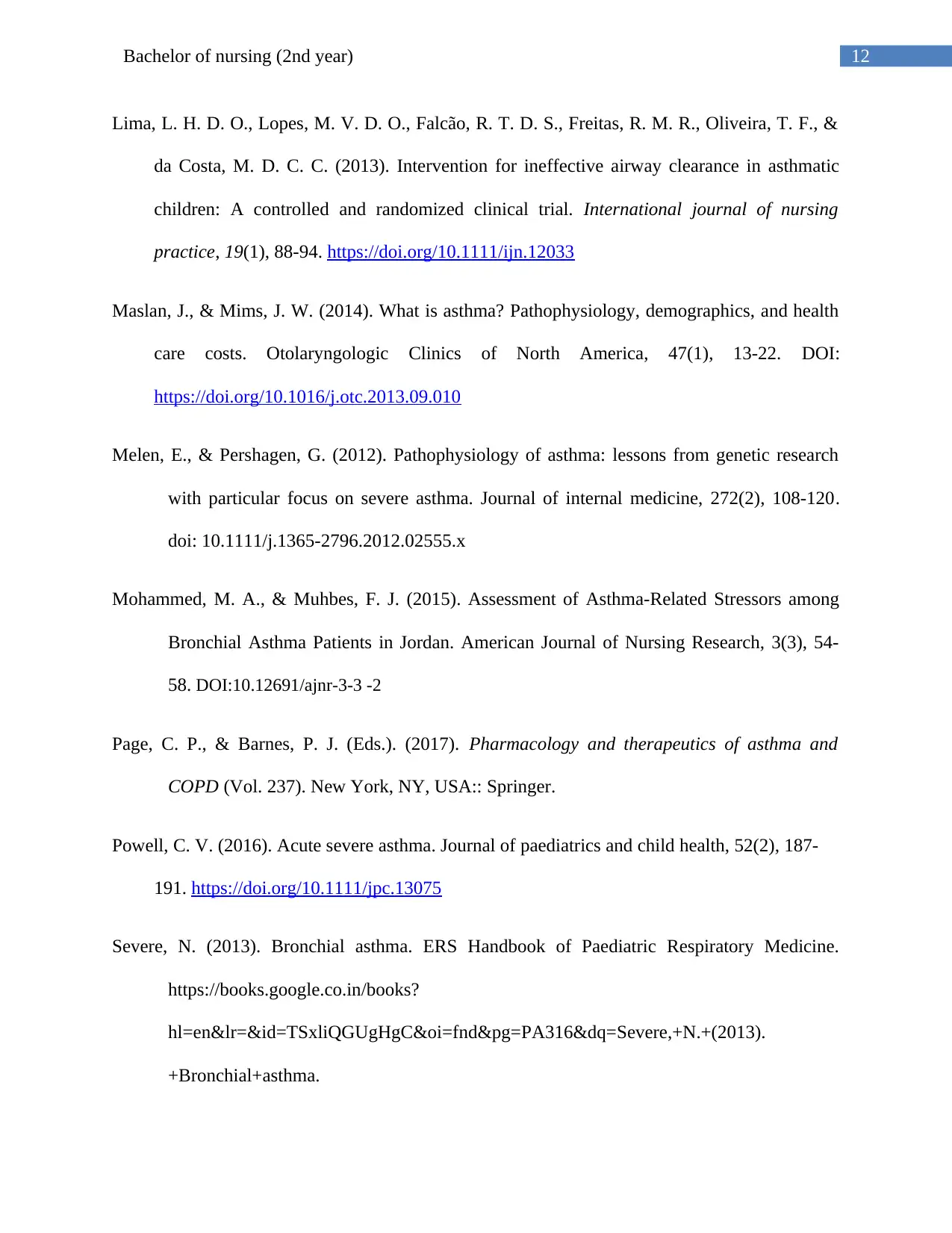
12Bachelor of nursing (2nd year)
Lima, L. H. D. O., Lopes, M. V. D. O., Falcão, R. T. D. S., Freitas, R. M. R., Oliveira, T. F., &
da Costa, M. D. C. C. (2013). Intervention for ineffective airway clearance in asthmatic
children: A controlled and randomized clinical trial. International journal of nursing
practice, 19(1), 88-94. https://doi.org/10.1111/ijn.12033
Maslan, J., & Mims, J. W. (2014). What is asthma? Pathophysiology, demographics, and health
care costs. Otolaryngologic Clinics of North America, 47(1), 13-22. DOI:
https://doi.org/10.1016/j.otc.2013.09.010
Melen, E., & Pershagen, G. (2012). Pathophysiology of asthma: lessons from genetic research
with particular focus on severe asthma. Journal of internal medicine, 272(2), 108-120.
doi: 10.1111/j.1365-2796.2012.02555.x
Mohammed, M. A., & Muhbes, F. J. (2015). Assessment of Asthma-Related Stressors among
Bronchial Asthma Patients in Jordan. American Journal of Nursing Research, 3(3), 54-
58. DOI:10.12691/ajnr-3-3 -2
Page, C. P., & Barnes, P. J. (Eds.). (2017). Pharmacology and therapeutics of asthma and
COPD (Vol. 237). New York, NY, USA:: Springer.
Powell, C. V. (2016). Acute severe asthma. Journal of paediatrics and child health, 52(2), 187-
191. https://doi.org/10.1111/jpc.13075
Severe, N. (2013). Bronchial asthma. ERS Handbook of Paediatric Respiratory Medicine.
https://books.google.co.in/books?
hl=en&lr=&id=TSxliQGUgHgC&oi=fnd&pg=PA316&dq=Severe,+N.+(2013).
+Bronchial+asthma.
Lima, L. H. D. O., Lopes, M. V. D. O., Falcão, R. T. D. S., Freitas, R. M. R., Oliveira, T. F., &
da Costa, M. D. C. C. (2013). Intervention for ineffective airway clearance in asthmatic
children: A controlled and randomized clinical trial. International journal of nursing
practice, 19(1), 88-94. https://doi.org/10.1111/ijn.12033
Maslan, J., & Mims, J. W. (2014). What is asthma? Pathophysiology, demographics, and health
care costs. Otolaryngologic Clinics of North America, 47(1), 13-22. DOI:
https://doi.org/10.1016/j.otc.2013.09.010
Melen, E., & Pershagen, G. (2012). Pathophysiology of asthma: lessons from genetic research
with particular focus on severe asthma. Journal of internal medicine, 272(2), 108-120.
doi: 10.1111/j.1365-2796.2012.02555.x
Mohammed, M. A., & Muhbes, F. J. (2015). Assessment of Asthma-Related Stressors among
Bronchial Asthma Patients in Jordan. American Journal of Nursing Research, 3(3), 54-
58. DOI:10.12691/ajnr-3-3 -2
Page, C. P., & Barnes, P. J. (Eds.). (2017). Pharmacology and therapeutics of asthma and
COPD (Vol. 237). New York, NY, USA:: Springer.
Powell, C. V. (2016). Acute severe asthma. Journal of paediatrics and child health, 52(2), 187-
191. https://doi.org/10.1111/jpc.13075
Severe, N. (2013). Bronchial asthma. ERS Handbook of Paediatric Respiratory Medicine.
https://books.google.co.in/books?
hl=en&lr=&id=TSxliQGUgHgC&oi=fnd&pg=PA316&dq=Severe,+N.+(2013).
+Bronchial+asthma.
You're viewing a preview
Unlock full access by subscribing today!
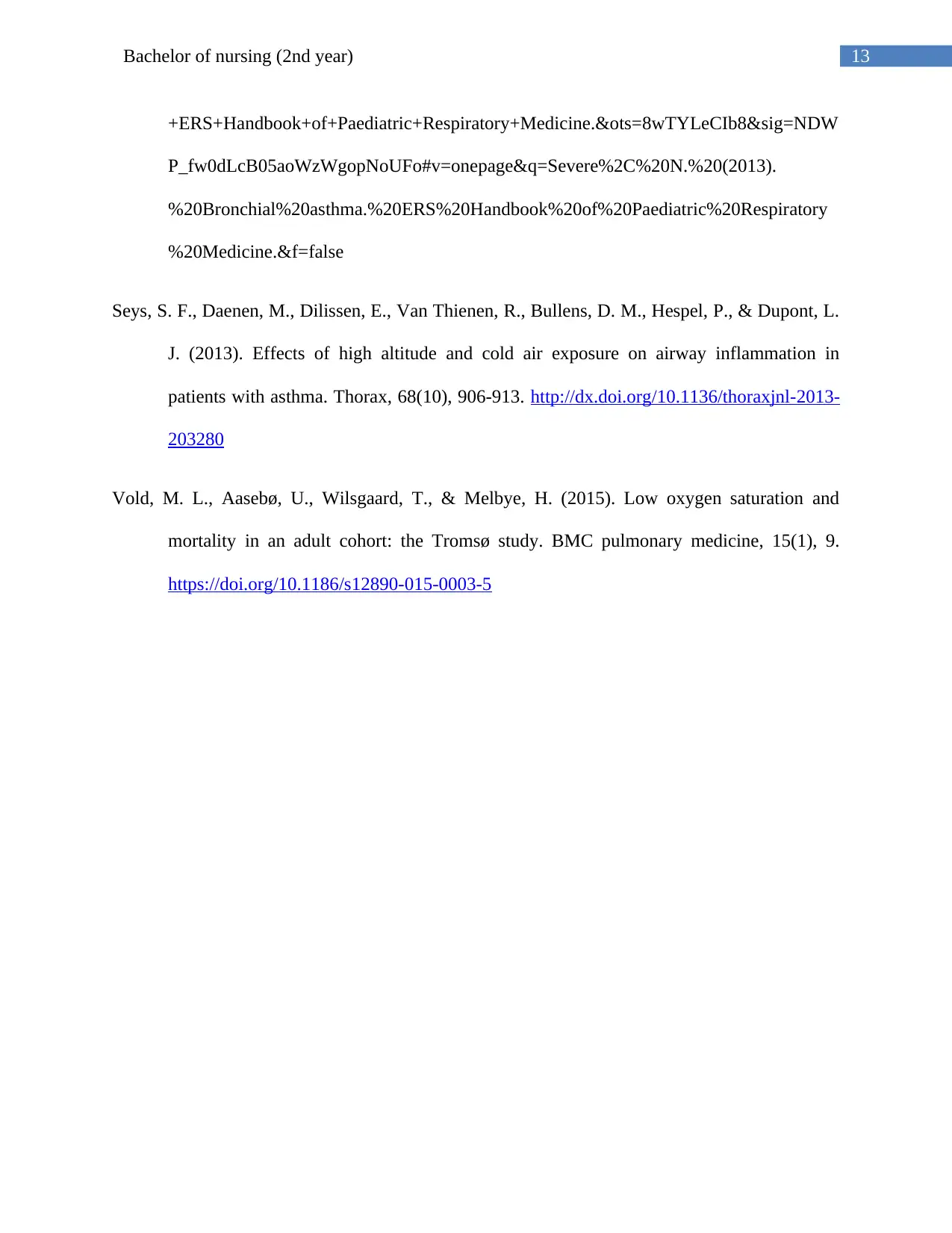
13Bachelor of nursing (2nd year)
+ERS+Handbook+of+Paediatric+Respiratory+Medicine.&ots=8wTYLeCIb8&sig=NDW
P_fw0dLcB05aoWzWgopNoUFo#v=onepage&q=Severe%2C%20N.%20(2013).
%20Bronchial%20asthma.%20ERS%20Handbook%20of%20Paediatric%20Respiratory
%20Medicine.&f=false
Seys, S. F., Daenen, M., Dilissen, E., Van Thienen, R., Bullens, D. M., Hespel, P., & Dupont, L.
J. (2013). Effects of high altitude and cold air exposure on airway inflammation in
patients with asthma. Thorax, 68(10), 906-913. http://dx.doi.org/10.1136/thoraxjnl-2013-
203280
Vold, M. L., Aasebø, U., Wilsgaard, T., & Melbye, H. (2015). Low oxygen saturation and
mortality in an adult cohort: the Tromsø study. BMC pulmonary medicine, 15(1), 9.
https://doi.org/10.1186/s12890-015-0003-5
+ERS+Handbook+of+Paediatric+Respiratory+Medicine.&ots=8wTYLeCIb8&sig=NDW
P_fw0dLcB05aoWzWgopNoUFo#v=onepage&q=Severe%2C%20N.%20(2013).
%20Bronchial%20asthma.%20ERS%20Handbook%20of%20Paediatric%20Respiratory
%20Medicine.&f=false
Seys, S. F., Daenen, M., Dilissen, E., Van Thienen, R., Bullens, D. M., Hespel, P., & Dupont, L.
J. (2013). Effects of high altitude and cold air exposure on airway inflammation in
patients with asthma. Thorax, 68(10), 906-913. http://dx.doi.org/10.1136/thoraxjnl-2013-
203280
Vold, M. L., Aasebø, U., Wilsgaard, T., & Melbye, H. (2015). Low oxygen saturation and
mortality in an adult cohort: the Tromsø study. BMC pulmonary medicine, 15(1), 9.
https://doi.org/10.1186/s12890-015-0003-5
1 out of 13
Related Documents
Your All-in-One AI-Powered Toolkit for Academic Success.
+13062052269
info@desklib.com
Available 24*7 on WhatsApp / Email
![[object Object]](/_next/static/media/star-bottom.7253800d.svg)
Unlock your academic potential
© 2024 | Zucol Services PVT LTD | All rights reserved.





